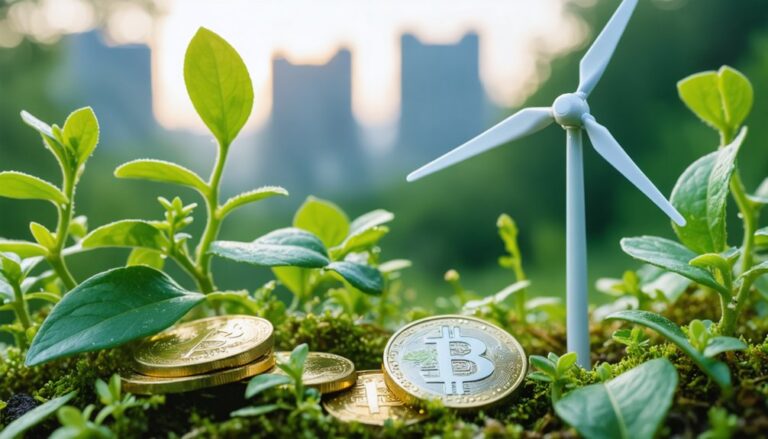The rise of green bonds signifies a crucial shift in investment, promoting sustainability through aligned capital flows. With the global market expanding substantially, green bonds support projects that mitigate climate change, enhance energy efficiency, and contribute to sustainable development. Strong regulatory structures and increasing ESG awareness reinforce investor confidence. Despite challenges like market volatility and concerns over greenwashing, the demand for these instruments continues to grow. Further perspectives reveal the changing landscape and future prospects for sustainable investments.
Highlights
- The global green bond market reached USD 673 billion in 2025, signaling a strong growth trajectory fueled by environmental investment demand.
- Regulatory supports like the EU Green Bond Standard enhance investor confidence by promoting transparency and minimizing greenwashing risks.
- Various green bond types fund environmentally beneficial projects, including energy-efficient buildings and sustainable waste management.
- Green bonds often outperform traditional bonds, reflecting their strong economic returns and increasing popularity among investors focused on sustainability.
- The market still faces challenges like regulatory inconsistencies and greenwashing concerns, yet forecasts suggest continued moderate growth opportunities in sustainable finance.
Understanding the Green Bond Market Landscape
As the demand for sustainable investment grows, understanding the green bond market scenery becomes increasingly essential. The global green bond market has evolved remarkably, standing at approximately USD 673 billion in 2025, with forecasts suggesting an ascent to USD 814 billion by 2030. This growth reflects strong market trends, as annual issuances reached record levels, driven by sturdy investor demand. Advanced economies, particularly in Europe and the United States, dominate the terrain, while emerging markets experience a decline in their share. The green bond market broke new records of issuance in 2024, highlighting the sector’s resilience and potential for continued growth. Additionally, the market has shown robust expansion, contributing to the USD 5.9 trillion in cumulative aligned volume seen by the end of Q1 2025. Corporate issuers lead the way, contributing substantially to the market’s expansion. As Asia-Pacific emerges as the fastest-growing market for green bonds, driven by initiatives in countries like China and Japan, a cohesive understanding of this thriving market can nurture a sense of belonging among investors seeking impactful and sustainable opportunities.
Key Drivers of Green Bond Issuance
While the green bond market continues to expand, several key drivers substantially influence the pace and volume of issuance. Regulatory support, such as the EU Green Bond Standard, enhances investor confidence by improving transparency and reducing greenwashing risks. This, coupled with growing ESG awareness, creates significant investor incentives for purchasing sustainable instruments. The demand for green bonds is further strengthened by the alignment of financial returns with environmental impact, nurturing market integrity through verified reporting. Additionally, favorable economic conditions, including falling interest rates, encourage issuers to participate actively in this sector. Together, these factors highlight how effective market regulation and investor demand are shaping the burgeoning scenery of green bond issuance. Notably, record issuance of US$447bn in 2024 marks a significant milestone, reflecting the growing interest and commitment towards sustainable finance. Furthermore, the global green bond issuance is projected to hit $1 trillion in 2025, showcasing the tremendous growth potential of this market. As the green bonds have surpassed US$3 trillion in cumulative issuances, there is a clear demonstration of the market’s increasing significance in channeling private capital for environmental projects.
Types of Green Bonds and Their Innovations
The scenery of green bonds encompasses a diverse array of instruments customized to fund environmentally beneficial projects, reflecting a commitment to sustainability. Core classifications include Standard Green Use of Proceeds Bonds, Green Revenue Bonds, and Green Project Bonds, alongside innovative variations like Blue Bonds and Green Asset-Backed Securities (ABS). These bond variations cater to different sector needs, such as marine conservation or renewable energy financing. Emerging instruments, including Green Collateralized Loan Obligations (CLOs) and Green Mortgages, integrate housing affordability with sustainability goals. This expansion in green innovations highlights a broader thematic focus, engaging a growing audience passionate about environmental stewardship. Additionally, green bonds can be used to finance various projects, including energy-efficient buildings and sustainable waste management. Collectively, these developments mark a significant evolution in the green finance terrain, bridging diverse investments with the urgent need for ecological preservation, while these innovations emphasize a broader thematic focus. Furthermore, the market for green bonds and green assets is growing fast, as investors increasingly prioritize environmentally compliant instruments.
Economic and Environmental Impacts of Green Bonds
With a growing diversity of green bond instruments designed to address various environmental challenges, attention has shifted toward their economic and environmental impacts. Green bonds have surged in global issuance, reaching approximately $572 billion in 2024, reflecting strong demand from sustainable finance initiatives. Their market capitalization has grown substantially, evidencing sturdy economic returns, with green bonds outperforming conventional bonds by nearly 2%. Environmentally, these instruments contribute to substantial reductions in greenhouse gas emissions by financing renewable energy and energy-efficient projects. However, while annual issuance is impressive, it still falls short of the estimated $2 trillion needed to meet climate goals, highlighting ongoing opportunities for collective action to take a plunge into the market. The potential for environmental benefits remains vast within this developing market, particularly as the green bond market has grown sixfold since 2018. Notably, the GSS+ market has reached a cumulative USD6 trillion in aligned issuance, underscoring the rapid growth and importance of these financial instruments in driving sustainability.
Challenges and Future Outlook for Green Bonds
Although green bonds have emerged as a vital tool in financing sustainable projects, they face several challenges that hinder their broader adoption and effectiveness, where they are an essential component.
Market volatility, compounded by inconsistent regulatory structures, complicates issuer confidence and investor trust.
The lack of a standardized definition of “green” creates confusion, while varying transparency and reporting requirements add complexity.
Additionally, the declining green premium raises questions about financial incentives for stakeholder engagement.
Amidst growing concerns about greenwashing, skepticism impacts the credibility of sustainability-linked bonds, deterring potential investments.
Nevertheless, forecasts indicate moderate growth in issuance, suggesting that opportunities abound, particularly as sustainability initiatives gain momentum and stakeholders increasingly prioritize comprehensive approaches to environmental, social, and governance criteria.
Conclusion
In summation, the green bond market represents a groundbreaking approach to financing sustainability, driven by increasing investor demand and a commitment to addressing climate change. As diverse types of green bonds emerge and innovate, they offer significant economic and environmental benefits. However, challenges remain in standardization and transparency. Looking ahead, the growth of the green bond sector is ready to play a vital role in shaping a sustainable future, attracting investments that prioritize both profit and planetary wellbeing.
References
- https://www.lseg.com/content/dam/lseg/en_us/documents/sustainability/investing-in-green-economy-2025.pdf
- https://www.netzeroinvestor.net/news-and-views/despite-it-all-what-explains-the-resilience-of-green-bonds
- https://www.mordorintelligence.com/industry-reports/green-bonds-market
- https://www.climatebonds.net/data-insights/publications/sustainable-debt-global-state-market-q1-2025
- https://www.bis.org/publ/qtrpdf/r_qt2503d.htm
- https://www.axa-im.com/sustainability/insights/good-bad-opportunities-green-bonds-2025
- https://cib.bnpparibas/sustainable-bonds-in-2025-navigating-an-evolving-market/
- https://www.maalot.co.il/Publications/ESGA20250605095955.pdf
- https://www.responsibleinvestment.org/events-news/item/the-good-the-bad-the-opportunities-green-bonds-in-2025
- https://cse-net.org/green-bonds-financing-america-sustainability/




